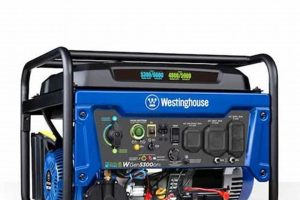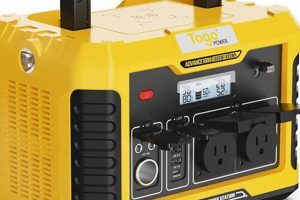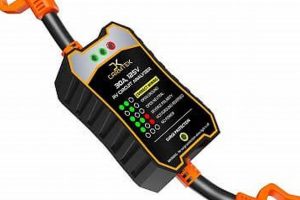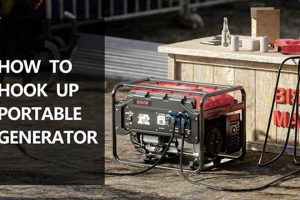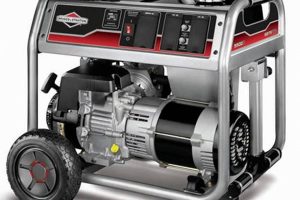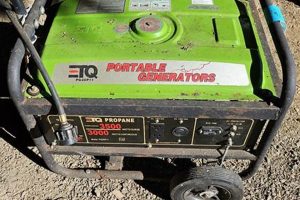A compact, fuel-powered device designed for on-the-go electricity generation offers a practical solution for power needs in various situations. Such devices typically provide sufficient power for small appliances, electronics, and tools, making them invaluable for camping, outdoor events, job sites, and emergency backup power during outages. Different models offer varied power outputs, fuel types (such as gasoline, propane, or diesel), and features like multiple outlets, USB ports, and quiet operation. Selecting the right unit depends on the specific power requirements and intended use.
Portable power solutions have become increasingly crucial in modern life, enabling individuals and businesses to maintain essential operations regardless of location or grid availability. The ability to have reliable electricity in remote areas or during power disruptions offers significant advantages, from powering essential medical equipment in emergencies to ensuring continuity for work and leisure activities. Technological advancements have led to more efficient, lightweight, and quieter models, broadening their applicability and appeal.
This discussion will further explore key considerations when selecting a portable power source, including power output, fuel efficiency, runtime, noise levels, and safety features. Understanding these aspects will empower informed decisions and ensure users choose the device that best meets their specific needs and circumstances.
Operating Tips for Portable Generators
Safe and efficient operation of portable generators requires careful attention to several key practices. These guidelines ensure optimal performance and mitigate potential hazards.
Tip 1: Proper Ventilation is Crucial: Always operate a generator outdoors in a well-ventilated area. Never run a generator indoors, including garages, basements, or crawl spaces, due to the risk of carbon monoxide poisoning.
Tip 2: Ground the Generator: Proper grounding protects against electrical shock. Consult the owner’s manual for grounding instructions specific to the unit.
Tip 3: Safe Refueling Practices: Allow the generator to cool completely before refueling. Gasoline and other fuels are highly flammable and pose a significant fire hazard when handled near hot engine components.
Tip 4: Dry Operation Considerations: Avoid operating the generator in wet or damp conditions. Use a canopy or other protective covering if necessary, ensuring adequate ventilation is maintained.
Tip 5: Regular Maintenance: Adhere to the manufacturer’s recommended maintenance schedule for oil changes, air filter cleaning, and spark plug replacement. Routine maintenance ensures optimal performance and prolongs the generator’s lifespan.
Tip 6: Load Management: Avoid overloading the generator. Calculate the total wattage of devices to be connected and ensure it is within the generator’s rated capacity. Overloading can damage the generator and connected devices.
Tip 7: Storage Best Practices: Store the generator in a dry, well-ventilated area, away from flammable materials. Drain the fuel tank before long-term storage to prevent stale fuel issues.
Adhering to these safety and operational guidelines will contribute to a positive and productive generator experience, maximizing its utility while minimizing potential risks.
Through understanding these essential aspects, users can confidently operate their portable generators safely and effectively, ensuring reliable power when needed.
1. Power Output
Power output represents a critical specification for portable generators, directly influencing the types and number of devices it can power. Understanding the power output of the iq2000 portable generator is crucial for matching the unit to specific power demands and avoiding overload. This section delves into the nuances of power output as it pertains to this specific generator type.
- Rated Power vs. Starting Power
Generators possess two key power ratings: rated (running) power and starting (peak) power. Rated power denotes the continuous power output the generator can sustain, while starting power signifies the higher, momentary surge of power available for starting motor-driven appliances. Devices with electric motors, such as refrigerators and air conditioners, often require a higher starting wattage than their running wattage. Matching these requirements to the iq2000s specifications is vital for reliable operation.
- Wattage Requirements of Common Devices
Different devices have varying wattage requirements. Small electronics like smartphones and laptops require significantly less power than appliances like microwaves or electric heaters. Understanding the typical wattage demands of intended devices allows users to accurately assess whether the iq2000s power output aligns with their needs. Overestimating the generator’s capacity can lead to overloading and potential damage.
- Impact of Power Output on Runtime
Power output and runtime are intrinsically linked. Higher power demands generally translate to shorter runtimes, assuming a constant fuel supply. The iq2000s runtime will vary depending on the load. Operating the generator at a lower load, well below its maximum rated output, can extend its runtime.
- Overload Protection
Overloading a generator can lead to damage to both the generator itself and the connected devices. Many generators, including potentially the iq2000, incorporate overload protection mechanisms such as circuit breakers. These safety features help prevent damage by interrupting the power supply in overload situations. However, relying solely on these mechanisms is not advisable; careful load management is essential.
Careful consideration of power output, in conjunction with an understanding of device requirements and runtime implications, ensures the effective and safe operation of the iq2000 portable generator. Matching the generators capabilities to the intended load is paramount for maximizing its utility and preventing potential damage.
2. Portability
Portability is a defining characteristic of generators like the iq2000, directly influencing their usability and suitability for various applications. This feature encompasses several key aspects that impact transportation, deployment, and overall practicality.
- Physical Dimensions and Weight
The physical size and weight of the iq2000 directly affect its portability. Compact dimensions and a manageable weight are crucial for easy transport and maneuverability, particularly in outdoor or remote settings. Heavier units may require additional assistance or specialized transport, limiting their practicality in certain situations. Information regarding the iq2000’s specific dimensions and weight is essential for evaluating its portability in relation to user needs and intended applications.
- Integrated Handles and Wheels
The presence and design of integrated handles and wheels significantly impact the ease of transport. Ergonomically designed handles and durable wheels facilitate moving the generator across various terrains. Features like telescoping handles and never-flat wheels further enhance portability, particularly over uneven ground or for longer distances. Careful consideration of these features is crucial for assessing the practicality of transporting the iq2000.
- Compact Storage
The ability to store the iq2000 efficiently is an important aspect of portability, especially when space is limited. A compact design that minimizes storage footprint allows for convenient storage in vehicles, closets, or other storage areas. This factor is particularly relevant for users who require a portable generator for occasional use or who have limited storage capacity.
- Suitability for Varied Environments
Portability extends beyond mere transport; it also encompasses the generator’s adaptability to diverse environments. Features like weather resistance and rugged construction enhance its suitability for outdoor use in varying weather conditions. The iq2000’s ability to withstand different environments contributes to its overall practicality and value in diverse applications.
The portability of the iq2000, encompassing size, weight, transport features, and environmental adaptability, significantly influences its suitability for various applications. Careful consideration of these facets, in relation to specific user requirements, ensures informed decisions and maximizes the generator’s utility across a range of scenarios.
3. Fuel Efficiency
Fuel efficiency represents a critical operational parameter for portable generators, directly impacting running costs and environmental impact. Analyzing fuel efficiency concerning the iq2000 portable generator requires considering several factors, including engine design, load management, and operational practices. A more fuel-efficient generator translates to lower operating costs and reduced environmental footprint.
The iq2000’s engine design plays a pivotal role in determining its fuel consumption rate. Advanced engine technologies, such as inverter technology, can significantly improve fuel efficiency compared to traditional generator designs. Inverter generators adjust engine speed dynamically based on the power demand, leading to optimized fuel consumption, particularly at lower loads. Understanding the iq2000’s engine technology provides insights into its potential fuel efficiency characteristics.
Load management significantly influences fuel consumption. Operating the generator at a lower load, well below its maximum rated output, generally results in improved fuel efficiency. Avoiding unnecessary loads and prioritizing essential power needs can extend runtime and reduce fuel costs. Practical examples include powering only essential appliances during a power outage or selectively using power-hungry devices while camping.
Operational practices further impact fuel efficiency. Regular maintenance, such as clean air filters and spark plugs, contributes to optimal engine performance and fuel economy. Using the correct fuel type and adhering to the manufacturer’s recommended maintenance schedule ensures the generator operates at peak efficiency. Ignoring maintenance can lead to decreased fuel efficiency and potentially engine damage.
Understanding the interplay between fuel efficiency, engine design, load management, and operational practices provides a comprehensive perspective on the iq2000’s performance characteristics. This knowledge empowers informed decisions regarding usage patterns and maintenance practices, ultimately contributing to cost savings and reduced environmental impact.
4. Runtime
Runtime, a crucial performance metric for portable generators, signifies the duration a generator can operate continuously on a single fuel tank. Understanding runtime characteristics is essential for effectively utilizing the iq2000 portable generator across diverse applications, from camping trips to emergency power supply during outages. This section explores the factors influencing runtime and their implications for practical use.
- Fuel Tank Capacity
The iq2000’s fuel tank capacity directly influences its potential runtime. A larger fuel tank generally translates to a longer runtime, assuming a constant power draw. However, fuel tank capacity must be considered in conjunction with fuel consumption rate to accurately estimate runtime under specific load conditions. Comparing the iq2000’s fuel tank capacity with other similar generators can provide valuable insights into its potential runtime capabilities.
- Power Demand and Load
The power demand placed on the generator significantly impacts runtime. Higher power draw reduces runtime, while lower power draw extends it. Operating the iq2000 at a lower load, by powering fewer devices or using less power-hungry appliances, can significantly prolong its runtime. Understanding the power requirements of intended devices allows users to estimate runtime more accurately and manage power consumption effectively.
- Engine Efficiency and Fuel Consumption Rate
Engine efficiency plays a crucial role in determining fuel consumption and, consequently, runtime. More efficient engines consume less fuel for a given power output, resulting in extended runtime. Features like inverter technology can enhance engine efficiency and optimize fuel consumption, particularly at lower loads. Information regarding the iq2000’s engine technology and fuel consumption rate provides valuable insights into its runtime potential.
- External Factors and Environmental Conditions
External factors, such as ambient temperature and altitude, can influence engine performance and fuel consumption, indirectly affecting runtime. Extreme temperatures or high altitudes can impact engine efficiency and potentially reduce runtime. Considering these environmental factors when estimating runtime provides a more realistic assessment of the iq2000’s performance in specific operating conditions.
Runtime, a function of fuel capacity, power demand, engine efficiency, and environmental conditions, represents a critical performance characteristic of the iq2000 portable generator. Understanding these factors empowers users to optimize usage patterns, effectively manage power consumption, and accurately estimate runtime based on specific needs and operating conditions. Careful consideration of runtime implications ensures the generator’s reliable performance across a range of applications, from recreational activities to essential backup power.
5. Noise Levels
Noise levels represent a critical consideration when evaluating portable generators, particularly in noise-sensitive environments. The acoustic output of the iq2000 portable generator directly impacts its suitability for various applications, ranging from residential use during power outages to recreational activities like camping. Understanding the factors influencing noise levels and their practical implications is essential for informed decision-making.
Several factors contribute to a generator’s noise output. Engine design, exhaust systems, and overall construction play significant roles. Generators equipped with advanced mufflers and noise-dampening technologies generally operate quieter than those with simpler designs. Operating conditions, such as load and engine speed, also influence noise levels. Higher loads typically result in increased engine speed and, consequently, higher noise output. External factors, such as surrounding terrain and vegetation, can further affect perceived noise levels. For instance, operating a generator in an open area might produce higher perceived noise compared to operating it within a partially enclosed space.
Practical implications of generator noise levels extend across various scenarios. In residential settings, excessive noise can disrupt daily life and potentially violate local noise ordinances. During camping trips, loud generators can detract from the tranquility of the outdoor experience. On job sites, high noise levels can contribute to worker fatigue and potentially pose safety hazards. Manufacturers often specify noise levels in decibels (dB) at a certain distance. Comparing these specifications across different generator models allows users to assess their relative noise output and choose a unit appropriate for their intended environment. Understanding the iq2000’s noise level specifications is crucial for minimizing noise-related disruptions and ensuring compatibility with specific usage scenarios. Selecting a quieter generator contributes to a more positive user experience and minimizes potential disturbances in noise-sensitive environments.
6. Safety Features
Safety features are paramount for portable generators, mitigating potential hazards associated with fuel-powered equipment and electricity generation. Integrating robust safety mechanisms into the design and operation of the iq2000 portable generator is crucial for protecting users and surrounding environments. This section explores key safety features and their implications for safe and reliable operation.
- Automatic Low-Oil Shutdown
Low oil levels can cause severe engine damage. An automatic low-oil shutdown feature safeguards the engine by automatically shutting down the generator when oil levels fall below a critical threshold. This feature prevents costly repairs and extends the generator’s lifespan. Its presence in the iq2000 contributes significantly to engine protection and operational longevity.
- Overload Protection
Overloading a generator can damage both the unit and connected devices. Overload protection features, such as circuit breakers, interrupt the power supply in overload situations, preventing damage from excessive current draw. The presence and functionality of overload protection in the iq2000 are crucial for safe operation and preventing electrical hazards.
- Carbon Monoxide (CO) Detection and Shutdown
Carbon monoxide (CO) poisoning presents a serious hazard associated with fuel-burning equipment. CO detection and shutdown systems monitor CO levels and automatically shut down the generator if dangerous concentrations are detected. This critical safety feature protects users from CO exposure, particularly in enclosed or poorly ventilated areas. The inclusion of a CO safety mechanism in the iq2000 enhances user safety and mitigates the risks associated with CO emissions.
- Spark Arrestor
Generators operating in dry or vegetated areas pose a potential fire hazard due to exhaust sparks. A spark arrestor, integrated into the exhaust system, traps and cools exhaust sparks, preventing them from igniting flammable materials. The presence of a spark arrestor in the iq2000 enhances fire safety, particularly in outdoor or wilderness settings. This feature underscores responsible operation and environmental protection.
The safety features incorporated into the iq2000 portable generator contribute significantly to its safe and reliable operation. These mechanisms mitigate potential hazards, protect users and surrounding environments, and enhance overall operational safety. Understanding these safety features and their functionalities is crucial for responsible generator use and maximizing user protection.
Frequently Asked Questions
This section addresses common inquiries regarding the iq2000 portable generator, providing concise and informative responses to facilitate informed decision-making and optimal product utilization.
Question 1: What is the maximum power output of the iq2000?
The maximum power output, encompassing both starting and running wattage, should be detailed in the product specifications. This information is crucial for determining the generator’s suitability for powering specific devices.
Question 2: What type of fuel does the iq2000 use?
Specific fuel requirements, whether gasoline, propane, or another fuel type, are outlined in the product documentation. Using the correct fuel type is essential for proper operation and preventing engine damage.
Question 3: What is the approximate runtime of the iq2000 on a full tank?
Runtime varies depending on load and operating conditions. Consult the product specifications for estimated runtime ranges under different load scenarios. This information helps users plan usage accordingly.
Question 4: How loud is the iq2000 during operation?
Noise levels, typically measured in decibels (dB), are usually provided in the product specifications. This information assists users in assessing the generator’s suitability for noise-sensitive environments.
Question 5: What safety features are incorporated into the iq2000?
Key safety features, such as overload protection, low-oil shutdown, and carbon monoxide detection, should be detailed in the product documentation. Understanding these features promotes safe and responsible generator operation.
Question 6: Where can one find the user manual and maintenance schedule for the iq2000?
The user manual, containing essential operational instructions and maintenance schedules, is typically included with the product or available online through the manufacturer’s website.
Careful consideration of these frequently asked questions and consultation of official product documentation provide a comprehensive understanding of the iq2000 portable generator, enabling informed purchase decisions and optimal product usage.
Further inquiries or specific technical questions should be directed to the manufacturer or authorized dealers for expert guidance.
Conclusion
The iq2000 portable generator represents a potential solution for diverse power needs, from recreational activities to emergency preparedness. Careful consideration of factors such as power output, fuel efficiency, runtime, noise levels, and safety features is crucial for selecting the appropriate generator for specific applications. Understanding operational guidelines and maintenance requirements ensures safe, reliable, and efficient performance, maximizing the generator’s utility and lifespan.
Informed decision-making, grounded in a thorough understanding of product specifications and operational best practices, empowers users to harness the full potential of portable power solutions. Investing in reliable and appropriately sized portable generators enhances preparedness for unforeseen power disruptions and facilitates access to electricity in off-grid locations, contributing to resilience and operational continuity in various scenarios.

